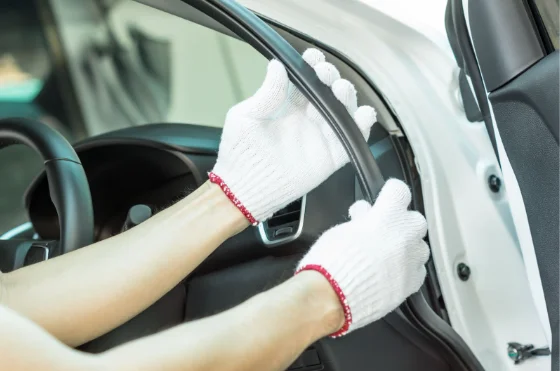Car weather stripping plays a pivotal role in maintaining the integrity and comfort of a vehicle’s interior. This rubber material seals the car’s doors, windows, trunk lid, windshield, and roof rails, protecting the cabin from external elements like water, debris, and noise. Depending on its location, weather stripping can vary in shape—most commonly O or U-shaped—and material, with some having a felt-like edge for better sealing.
Car Weather Stripping
Automotive weather stripping is designed to seal the vehicle’s interior against environmental conditions, ensuring a comfortable and protected cabin space. It is a crucial component that prevents water and debris from entering the vehicle and helps maintain consistent interior temperature levels by minimizing heat loss or air conditioning. The efficiency of weather stripping significantly contributes to a vehicle’s overall performance in terms of comfort and durability.
Signs of Weather Stripping Wear and Tear
The deterioration of weather stripping is often a result of age, exposure to extreme heat, or harsh sunlight. Signs that your vehicle’s weather stripping may need attention include:
- Material becoming brittle, loose, compressed, torn, or frayed.
- The wetness on the carpet, upholstery, or around the trunk indicates water seepage.
- Noticeable wind noise while driving, despite all windows being closed.
- As pointed out by Advance Auto Parts, the need for abnormal temperature adjustments inside the cabin suggests a breach in the vehicle’s insulation.
Diagnosing Weather Stripping Issues
To accurately diagnose weather stripping issues, vehicle owners can employ several methods:
- Listening for Wind Noise: Increased wind noise while driving can indicate a seal failure.
- Visual Inspection: Regular checks for physical damage to the stripping can preempt water leaks.
- Water Test Method: Spraying the vehicle with water and observing for any leaks can help pinpoint the exact location of a failing seal.
Locating the precise area of failure is essential due to water’s ability to travel far from its entry point along the seal.
Replacing Weather Stripping
Choosing the right replacement is crucial, with options ranging from factory (OEM) to aftermarket parts. While factory parts may offer a better fit, aftermarket alternatives can provide a more cost-effective solution without significantly compromising quality.
Step-by-Step Replacement Guide:
- Removal: Start by removing any screws securing the old stripping, then carefully pull the piece free.
- Cleaning: Use a solvent like brake cleaner to remove old adhesive residue, wearing gloves for protection.
- Application: Apply a thin bead of new adhesive to the cleaned area, press the new weather stripping firmly in place, and replace any removed screws.
- Final Touches: Allow the adhesive to dry as recommended before applying a silicone-based spray to the new weather stripping for added durability.
Windshield weather stripping may require professional assistance, especially involving specialized molding.
Maintenance and Care for Weather Stripping
Regular maintenance can significantly extend the life of weather stripping. Simple cleaning and applying a silicone-based spray can prevent premature wear and tear. Vehicle owners should seek professional advice when faced with complex weather stripping issues, ensuring the vehicle remains sealed against the elements.
Conclusion
Weather stripping in vehicles is pivotal, balancing comfort, safety, and durability by shielding the interior from environmental adversities. It prevents moisture, debris, and noise intrusion, directly impacting vehicle longevity and occupant comfort.
Regular inspections and timely replacement of compromised weather stripping are essential. Proper maintenance not only preserves your vehicle’s condition but also protects your investment, ensuring a serene and secure driving experience. This proactive approach guarantees the car remains a reliable sanctuary on the road.
FAQs on Car Weather Stripping
Can I replace car weather stripping myself, or do I need a professional?
While many weather stripping replacements can be a DIY project, especially with adhesive-backed products, some situations may require professional installation. This is particularly true for windshield weather stripping, which might need special tools or techniques.
How often should weather stripping be replaced?
There’s no one-size-fits-all answer, as the durability of weather stripping depends on various factors such as material quality, exposure to elements, and vehicle usage. Regular inspections can help determine when replacements are needed.
What materials are used for weather stripping?
Weather stripping is commonly made from rubber or silicone, with some types incorporating a felt-like material for additional sealing against debris.
Can weather stripping affect my car’s energy efficiency?
Yes, effective weather stripping seals the cabin, preventing heat loss or gain and reducing the need for excessive heating or air conditioning. This can indirectly impact fuel efficiency.
Can weather stripping be repaired, or does it always need to be replaced?
Minor issues may be repairable with adhesive or sealant, but extensive damage typically requires replacement to ensure a proper seal.
Get the right coverage for your car with tutenagency
New tutenagency customers?
Quote auto insurance online or call (334) 502-5111 to insure your vehicle.
Disclaimer: This content is for informational purposes only and should not be considered legal or financial advice. Always consult with qualified professionals in legal and financial fields before making any decisions.

